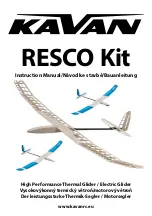
1.3 Brake Lines
The brake lines connect to the trailing edge via a series of subsidiary lines.
Because of their positions they are more easily scuffed than other lines on
your glider, so they should be checked more frequently.
The main brake lines run through pulleys connected to the rear risers. The
brake handles are tied to the main lines and conveniently positioned press-
studs attach them to the risers when not in use. This should prevent them from
twisting and tangling.
The brake lines are tested and adjusted at the plant. They are marked by the
inspector and have been flown by test pilots. The markings serve as a default
setting from which an individualized setting should be made. We recommend
that the brake lines be adjusted to the actual pilot at a practice area. The
points should be followed:
Ensure both main lines are of equal length.
If brake handles have been removed for any reason, check that the line is still
routed through the pulley when it is replaced.
When brake handles are released in flight the brake lines should be slack.
There should be substantial “bow” in them and absolutely no deformation of
the trailing edge.
Changes made in small steps but still maintain the possibility for full travel from
trimmed speed to stall.
We recommend a minimum of 10 cm of free play between the brake release
position and the start of deformation on the glider. This will prevent the trailing
edge from being deformed when using the speed system.
In the unlikely event of a brake handle becoming detached, or a brake line
snapping in flight, the glider can be flown by gently pulling the rear risers (D-
risers) for directional control.
As you can well imagine, there are several knots that can be used to
secure the line to the control handle, however as pictured below is
Firebirds recommendation.
















































